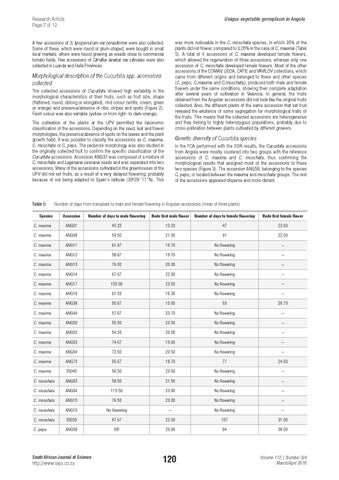Research Article Page 7 of 12
Unique vegetable germplasm in Angola
was more noticeable in the C. moschata species, in which 35% of the plants did not flower, compared to 0,05% in the case of C. maxima (Table 5). A total of 4 accessions of C. maxima developed female flowers, which allowed the regeneration of three accessions, whereas only one accession of C. moschata developed female flowers. Most of the other accessions of the COMAV, USDA, CATIE and VAVILOV collections, which came from different origins and belonged to these and other species (C. pepo, C.maxima and C.moschata), produced both male and female flowers under the same conditions, showing their complete adaptation after several years of cultivation in Valencia. In general, the fruits obtained from the Angolan accessions did not look like the original fruits collected. Also, the different plants of the same accession that set fruit revealed the existence of some segregation for morphological traits of the fruits. This means that the collected accessions are heterogeneous and they belong to highly heterozygous populations, probably due to cross-pollination between plants cultivated by different growers.
A few accessions of S. lycopersicum var cerasiforme were also collected. Some of these, which were round or plum-shaped, were bought in small local markets; others were found growing as weeds close to commercial tomato fields. Five accessions of Citrullus lanatus var citroides were also collected in Luanda and Huíla Provinces.
Morphological description of the Cucurbita spp. accessions collected The collected accessions of Cucurbita showed high variability in the morphological characteristics of their fruits, such as fruit size, shape (flattened, round, oblong or elongated), rind colour (white, cream, green or orange) and presence/absence of ribs, stripes and spots (Figure 2). Flesh colour was also variable (yellow or from light- to dark-orange). The cultivation of the plants at the UPV permitted the taxonomic classification of the accessions. Depending on the seed, leaf and flower morphologies, the presence/absence of spots on the leaves and the plant growth habit, it was possible to classify the accessions as C. maxima, C. moschata or C. pepo. The peduncle morphology was also studied in the originally collected fruit to confirm the specific classification of the Cucurbita accessions. Accession ANG37 was composed of a mixture of C. moschata and Lagenaria siceraria seeds and was separated into two accessions. Many of the accessions cultivated in the greenhouses of the UPV did not set fruits, as a result of a very delayed flowering, probably because of not being adapted to Spain’s latitude (39°28´11˝N). This
Table 5:
Genetic diversity of Cucurbita species In the FCA performed with the SSR results, the Cucurbita accessions from Angola were mostly clustered into two groups with the reference accessions of C. maxima and C. moschata, thus confirming the morphological results that assigned most of the accessions to these two species (Figure 3). The accession ANG58, belonging to the species C. pepo, is located between the maxima and moschata groups. The rest of the accessions appeared disperse and more distant.
Number of days from transplant to male and female flowering in Angolan accessions (mean of three plants)
Species
Accession
Number of days to male flowering
Node first male flower
Number of days to female flowering
Node first female flower
C. maxima
ANG01
45.33
10.33
47
23.00
C. maxima
ANG08
59.50
21.00
91
22.00
C. maxima
ANG11
61.67
19.70
No flowering
–
C. maxima
ANG12
58.67
19.70
No flowering
–
C. maxima
ANG13
76.00
20.00
No flowering
–
C. maxima
ANG14
67.67
22.00
No flowering
–
C. maxima
ANG17
155.00
23.50
No flowering
–
C. maxima
ANG18
61.33
16.30
No flowering
–
C. maxima
ANG38
50.67
15.00
59
26.70
C. maxima
ANG44
57.67
23.70
No flowering
–
C. maxima
ANG50
55.50
23.50
No flowering
–
C. maxima
ANG52
54.33
20.00
No flowering
–
C. maxima
ANG53
74.67
19.00
No flowering
–
C. maxima
ANG54
72.50
20.50
No flowering
–
C. maxima
ANG73
55.67
18.70
77
24.00
C. maxima
35040
56.50
23.50
No flowering
–
C. moschata
ANG03
58.50
21.50
No flowering
–
C. moschata
ANG04
115.50
23.00
No flowering
–
C. moschata
ANG15
76.50
23.00
No flowering
–
C. moschata
ANG16
No flowering
–
No flowering
–
C. moschata
35039
87.67
22.00
107
31.00
C. pepo
ANG58
592
20.00
64
38.00
South African Journal of Science
http://www.sajs.co.za
120
Volume 112 | Number 3/4 March/April 2016
